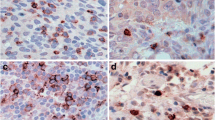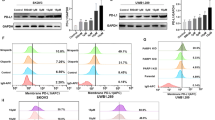Abstract
We evaluated the expression of tissue factor (TF) in ovarian cancer (EOC) and the potential of hI-con1, an antibody-like molecule targeting TF, as a novel form of therapy against chemotherapy-resistant ovarian disease. We studied the expression of TF in 88 EOC by immunohistochemistry (IHC) and real-time-PCR (qRT-PCR) and the levels of membrane-bound-complement-regulatory-proteins CD46, CD55 and CD59 in primary EOC cell lines by flow-cytometry. Sensitivity to hI-con1-dependent-cell-mediated-cytotoxicity (IDCC), complement-dependent-cell-cytotoxicity and inhibition of IDCC by γ-immunoglobulin were evaluated in 5-h 51chromium-release-assays. Cytoplasmic and/or membrane TF expression was observed in 24 out of 25 (96%) of the EOC samples tested by IHC, but not in normal ovarian-tissue. EOC with clear cell histology significantly overexpress TF when compared to serous, endometrioid, or undifferentiated tumors by qRT-PCR. With a single exception, all primary EOC that overexpressed TF demonstrated high levels of CD46, CD55 and CD59 and regardless of their histology or resistance to chemotherapy, were highly sensitive to IDCC. The effect of complement and physiologic doses of γ-immunoglobulin on IDCC in ovarian cancer cell lines overexpressing TF was tumor specific and related to the overexpression of CD59 on tumor cells. Small-interfering-RNA-mediated knockdown of CD59 expression in ovarian tumors significantly increased hI-con1-mediated cytotoxic activity in vitro. Finally, low doses of interleukin-2 further increased the cytotoxic effect induced by hI-con1 (P < 0.01). hI-con1 molecule induces strong cytotoxicity against primary chemotherapy-resistant ovarian cancer cell lines overexpressing TF and may represent a novel therapeutic agent for the treatment of ovarian tumors refractory to standard treatment modalities.





Similar content being viewed by others
Abbreviations
- TF:
-
Tissue factor
- fVII:
-
Factor VII
- hI-con1:
-
Human immuno-conjugate molecule
- IDCC:
-
hI-con1-dependent cell-mediated cytotoxicity
- FBS:
-
Fetal bovine serum
- IHC:
-
Immunohistochemistry
- mAb:
-
Monoclonal antibody
- NK cells:
-
Natural killer cells
- PBL:
-
Peripheral blood lymphocytes
- qRT-PCR:
-
Quantitative real-time-polymerase chain reaction
- CC:
-
Clear cell carcinoma
- OSPC:
-
Ovarian serous papillary carcinoma
References
Jemal A, Siegel R, Xu J, Ward E (2010) Cancer statistics, 2010. CA Cancer J Clin 60:277–300
Cho KR, Shih I (2009) Ovarian cancer. Annu Rev Pathol 4:287–313
Bamberger ES, Perrett CW (2002) Angiogenesis in epithelian ovarian cancer. Mol Pathol 55:348–359
Papetti M, Herman IM (2002) Mechanisms of normal and tumor-derived angiogenesis. Am J Physiol Cell Physiol 282:947–970
Contrino J, Hair G, Kreutzer DL, Rickles FR (1996) In situ detection of tissue factor in vascular endothelial cells: correlation with the malignant phenotype of human breast disease. Nat Med 2:209–215
Abe K, Shoji M, Chen J, Bierhaus A, Danave I, Micko C, Casper K, Dillehay DL, Nawroth PP, Rickles FR (1999) Regulation of vascular endothelial growth factor production and angiogenesis by the cytoplasmic tail of tissue factor. Proc Natl Acad Sci USA 96:8663–8668
Hollingsworth HC, Steinberg SM, Silverberg SG, Merino MJ (1996) Advanced stage transitional cell carcinoma of the ovary. Hum Pathol 27:1267–1272
Ruf W (2007) Tissue factor and PAR signaling in tumor progression. Thromb Res 120:S7–S12
Hu Z, Sun Y, Garen A (1999) Targeting tumor vasculature endothelial cells and tumor cells for immunotherapy of human melanoma in a mouse xenograft model. Proc Natl Acad Sci USA 96:8161–8166
Hu Z, Garen A (2000) Intratumoral injection of adenoviral vectors encoding tumor-targeted immunoconjugates for cancer immunotherapy. Proc Natl Acad Sci USA 97:9221–9225
Hu Z, Garen A (2001) Targeting tissue factor on tumor vascular endothelial cells and tumor cells for immunotherapy in mouse models of prostatic cancer. Proc Natl Acad Sci USA 98:12180–12185
Waxman E, Ross JB, Laue TM, Guha A, Thiruvikraman SV, Lin TC, Konigsberg WH, Nemerson Y (1992) Tissue factor and its extracellular soluble domain: the relationship between intermolecular association with factor VIIa and enzymatic activity of the complex. Biochemistry 31:3998–4003
Presta L, Sims P, Meng YG, Moran P, Bullens S, Bunting S, Schoenfeld J, Lowe D, Lai J, Rancatore P, Iverson M, Lim A, Chisholm V, Kelley RF, Riederer M, Kirchhofer D (2001) Generation of a humanized, high affinity anti-tissue factor antibody for use as a novel antithrombotic therapeutic. Thromb Haemost 85:379–389
Dickinson CD, Kelly CR, Ruf W (1996) Identification of surface residues mediating tissue factor binding and catalytic function of the serine protease factor VIIa. Proc Natl Acad Sci USA 93:14379–14384
Gelderman KA, Tomlinson S, Ross GD, Gorter A (2004) Complement function in mAb-mediated cancer immunotherapy. Trends Immunol 25(3):158–164
Richter CE, Cocco E, Bellone S, Silasi DA, Ruttinger D, Azodi M, Schwartz PE, Rutherford TJ, Pecorelli S, Santin AD (2010) High-grade, chemotherapy-resistant ovarian carcinomas overexpress epithelial cell adhesion molecule (EpCAM) and are highly sensitive to immunotherapy with MT201, a fully human monoclonal anti-EpCAM antibody. Am J Obstet Gynecol 203:582.e1–582.e7
Preithner S, Elm S, Lippold S, Locher M, Wolf A, da Silva AJ, Baeuerle PA, Prang NS (2006) High concentrations of therapeutic IgG1 antibodies are needed to compensate for inhibition of antibody-dependent cellular cytotoxicity by excess endogenous immunoglobulin G. Mol Immunol 43:1183–1193
Kaushal V, Mukunyadzi P, Siegel ER, Dennis RA, Johnson DE, Kohli M (2008) Expression of tissue factor in prostate cancer correlates with malignant phenotype. Appl Immunohistochem Mol Morphol 16:1–6
Santin AD, Hermonat PL, Ravaggi A, Chiriva-Internati M, Zhan D, Pecorelli S, Parham GP, Cannon MJ (1999) Induction of human papillomavirus-specific CD4(+) and CD8(+) lymphocytes by E7-pulsed autologous dendritic cells in patients with human papillomavirus type 16- and 18-positive cervical cancer. J Virol 73:5402–5410
O’Brien ME, Schofield JB, Tan S, Fryatt I, Fisher C, Wiltshaw E (1993) Clear cell epithelial ovarian cancer (mesonephroid): bad prognosis only in early stages. Gynecol Oncol 49:250–254
Sugiyama T, Kamura T, Kigawa J, Terakawa N, Kikuchi Y, Kita T, Suzuki M, Sato I, Taguchi K (2000) Clinical characteristics of clear cell carcinoma of the ovary: a distinct histologic type with poor prognosis and resistance to platinum-based chemotherapy. Cancer 88:2584–2589
Itamochi H, Kigawa J, Sugiyama T, Kikuchi Y, Suzuki M, Terakawa N (2002) Low proliferation activity may be associated with chemoresistance in clear cell carcinoma of the ovary. Obstet Gynecol 100:281–287
Alessi P, Ebbinghaus C, Neri D (2004) Molecular targeting of angiogenesis. Biochim Biophys Acta 1654:39–49
Satoh T, Oki A, Uno K, Sakurai M, Ochi H, Okada S, Minami R, Matsumoto K, Tanaka YO, Tsunoda H, Homma S, Yoshikawa H (2007) High incidence of silent venous thromboembolism before treatment in ovarian cancer. Br J Cancer 97:1053–1057
Uno K, Homma S, Satoh T, Nakanishi K, Abe D, Matsumoto K, Oki A, Tsunoda H, Yamaguchi I, Nagasawa T, Yoshikawa H, Aonuma K (2007) Tissue factor expression as a possible determinant of thromboembolism in ovarian cancer. Br J Cancer 96:290–295
Koizume S, Jin MS, Miyagi E, Hirahara F, Nakamura Y, Piao JH, Asai A, Yoshida A, Tsuchiya E, Ruf W, Miyagi Y (2006) Activation of cancer cell migration and invasion by ectopic synthesis of coagulation factor VII. Cancer Res 66:9453–9460
Fang J, Wei WN, Xia LH, Song SJ (2004) The effects of tissue factor/activated factor VII complex on the invasion and metastasis of human ovarian cancer. Chung Hua Hsueh Yeh Hsueh Tsa Chi 25:523–527
Han LY, Landen CN Jr, Kamat AA, Lopez A, Bender DP, Mueller P, Schmandt R, Gershenson DM, Sood AK (2006) Preoperative serum tissue factor levels are an independent prognostic factor in patients with ovarian carcinoma. J Clin Oncol 24:755–761
Mueller BM, Reisfeld RA, Edgington TS, Ruf W (1992) Expression of tissue factor by melanoma cells promotes efficient hematogenous metastasis. Proc Natl Acad Sci USA 89:11832–11836
Yu JL, May L, Lhotak V, Shahrzad S, Shirasawa S, Weitz JI, Coomber BL, Mackman N, Rak JW (2005) Oncogenic events regulate tissue factor expression in colorectal cancer cells: implications for tumor progression and angiogenesis. Blood 105:1734–1741
Cocco E, Hu Z, Richter CE, Bellone S, Casagrande F, Bellone M, Todeschini P, Krikun G, Silasi DA, Azodi M, Schwartz PE, Rutherford TJ, Buza N, Pecorelli S, Lockwood CJ, Santin AD (2010) hI-con1, a factor VII-IgGFc chimeric protein targeting tissue factor for immunotherapy of uterine serous papillary carcinoma. Br J Cancer 103:812–819
Brodbeck WG, Mold C, Atkinson JP, Medof ME (2000) Cooperation between decay-accelerating factor and membrane cofactor protein in protecting cells from autologous complement attack. J Immunol 165:3999–4006
Shi XX, Zhang B, Zang JL, Wang GY, Gao MH (2009) CD59 silencing via retrovirus-mediated RNA interference enhanced complement-mediated cell damage in ovary cancer. Cell Mol Immunol 6:61–66
Ortaldo JR, Woodhouse C, Morgan AC, Herberman RB, Cheresh DA, Reisfeld R (1987) Analysis of effector cells in human antibody-dependent cellular cytotoxicity with murine monoclonal antibodies. J Immunol 138:3566–3572
Clynes RA, Towers TL, Presta LG, Ravetch JV (2000) Inhibitory Fc receptors modulate in vivo cytoxicity against tumor targets. Nat Med 6:443–446
Fehniger TA, Bluman EM, Porter MM, Mrózek E, Cooper MA, Van Deusen JB, Frankel SR, Stock W, Caligiuri MA (2000) Potential mechanisms of human natural killer cell expansion in vivo during low-dose IL-2 therapy. J Clin Invest 106:117–124
Caron PC, Lai LT, Scheinberg DA (1995) Interleukin-2 enhancement of cytotoxicity by humanized monoclonal antibody M195 (anti-CD33) in myelogenous leukemia. Clin Cancer Res 1:63–70
Krikun G, Hu Z, Osteen K, Bruner-Tran KL, Schatz F, Taylor HS, Toti P, Arcuri F, Konigsberg W, Garen A, Booth CJ, Lockwood CJ (2010) The immunoconjugate “icon” targets aberrantly expressed endothelial tissue factor causing regression of endometriosis. Am J Pathol 176:1050–1056
Tezel TH, Bodek E, Sonmez K, Kaliappan S, Kaplan HJ, Hu Z, Garen A (2007) Targeting tissue factor for immunotherapy of choroidal neovascularization by intravitreal delivery of factor VII-Fc chimeric antibody. Ocular Immunol Inflamm 15:3–10
Acknowledgments
Supported in part by grants from NIH R01 CA122728-01A2 to AS, and grants 501/A3/3 and 0027557 from the Italian Institute of Health (ISS) to AS. This investigation was also supported by NIH Research Grant CA-16359 from the National Cancer Institute. The Authors thank Dr. William Konigsberg, Dr. Alan Garen and Dr. Zhiwei Hu for initiating the collaboration with CJL on Icon immunotherapy of human gynecologic malignancies and Iconic Therapeutics Inc. for providing hI-con1 protein free of charge for our studies.
Author information
Authors and Affiliations
Corresponding author
Rights and permissions
About this article
Cite this article
Cocco, E., Varughese, J., Buza, N. et al. Tissue factor expression in ovarian cancer: implications for immunotherapy with hI-con1, a factor VII-IgGFc chimeric protein targeting tissue factor. Clin Exp Metastasis 28, 689–700 (2011). https://doi.org/10.1007/s10585-011-9401-0
Received:
Accepted:
Published:
Issue Date:
DOI: https://doi.org/10.1007/s10585-011-9401-0




